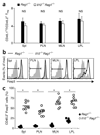Interleukin 10 acts on regulatory T cells to maintain expression of the transcription factor Foxp3 and suppressive function in mice with colitis
- PMID: 19783988
- PMCID: PMC2898179
- DOI: 10.1038/ni.1791
Interleukin 10 acts on regulatory T cells to maintain expression of the transcription factor Foxp3 and suppressive function in mice with colitis
Abstract
Regulatory T cells (T(reg) cells) that express the transcription factor Foxp3 suppress the activity of other cells. Here we show that interleukin 10 (IL-10) produced by CD11b(+) myeloid cells in recombination-activating gene 1-deficient (Rag1(-/-)) recipient mice was needed to prevent the colitis induced by transferred CD4(+)CD45RB(hi) T cells. In Il10(-/-)Rag1(-/-) mice, T(reg) cells failed to maintain Foxp3 expression and regulatory activity. The loss of Foxp3 expression occurred only in recipients with colitis, which indicates that the requirement for IL-10 is manifested in the presence of inflammation. IL-10 receptor-deficient (Il10rb(-/-)) T(reg) cells also failed to maintain Foxp3 expression, which suggested that host IL-10 acted directly on the T(reg) cells. Our data indicate that IL-10 released from myeloid cells acts in a paracrine manner on T(reg) cells to maintain Foxp3 expression.
Figures








Comment in
-
The gut feeling of Treg cells: IL-10 is the silver lining during colitis.Nat Immunol. 2009 Nov;10(11):1141-3. doi: 10.1038/ni1109-1141. Nat Immunol. 2009. PMID: 19841645
References
-
- Powrie F, Leach MW, Mauze S, Caddle LB, Coffman RL. Phenotypically distinct subsets of CD4+ T cells induce or protect from chronic intestinal inflammation in C. B-17 scid mice. Int. Immunol. 1993;5:1461–1471. - PubMed
-
- Powrie F, et al. Inhibition of Th1 responses prevents inflammatory bowel disease in scid mice reconstituted with CD45RBhi CD4+ T cells. Immunity. 1994;1:553–562. - PubMed
-
- Mottet C, Uhlig HH, Powrie F. Cutting edge: cure of colitis by CD4+CD25+ regulatory T cells. J. Immunol. 2003;170:3939–3943. - PubMed
-
- Annacker O, et al. CD25+CD4+ T cells regulate the expansion of peripheral CD4 T cells through the production of IL-10. J. Immunol. 2001;166:3008–3018. - PubMed
Publication types
MeSH terms
Substances
Grants and funding
LinkOut - more resources
Full Text Sources
Other Literature Sources
Molecular Biology Databases
Research Materials

